Lathe tools are old yet diverse machinery tools unique to lathing operations in part manufacturing. There are several types of lathe tools, each type with distinct structures, material makeup, functions, etc., which result in different applications.
The part quality is achievable with different turning tools depending on your level of understanding of their designs, properties, and functions. Hence, this article discusses the classifications of different cutting tools used in lathe machines and how to choose the right one.
What is a Lathe Machine?
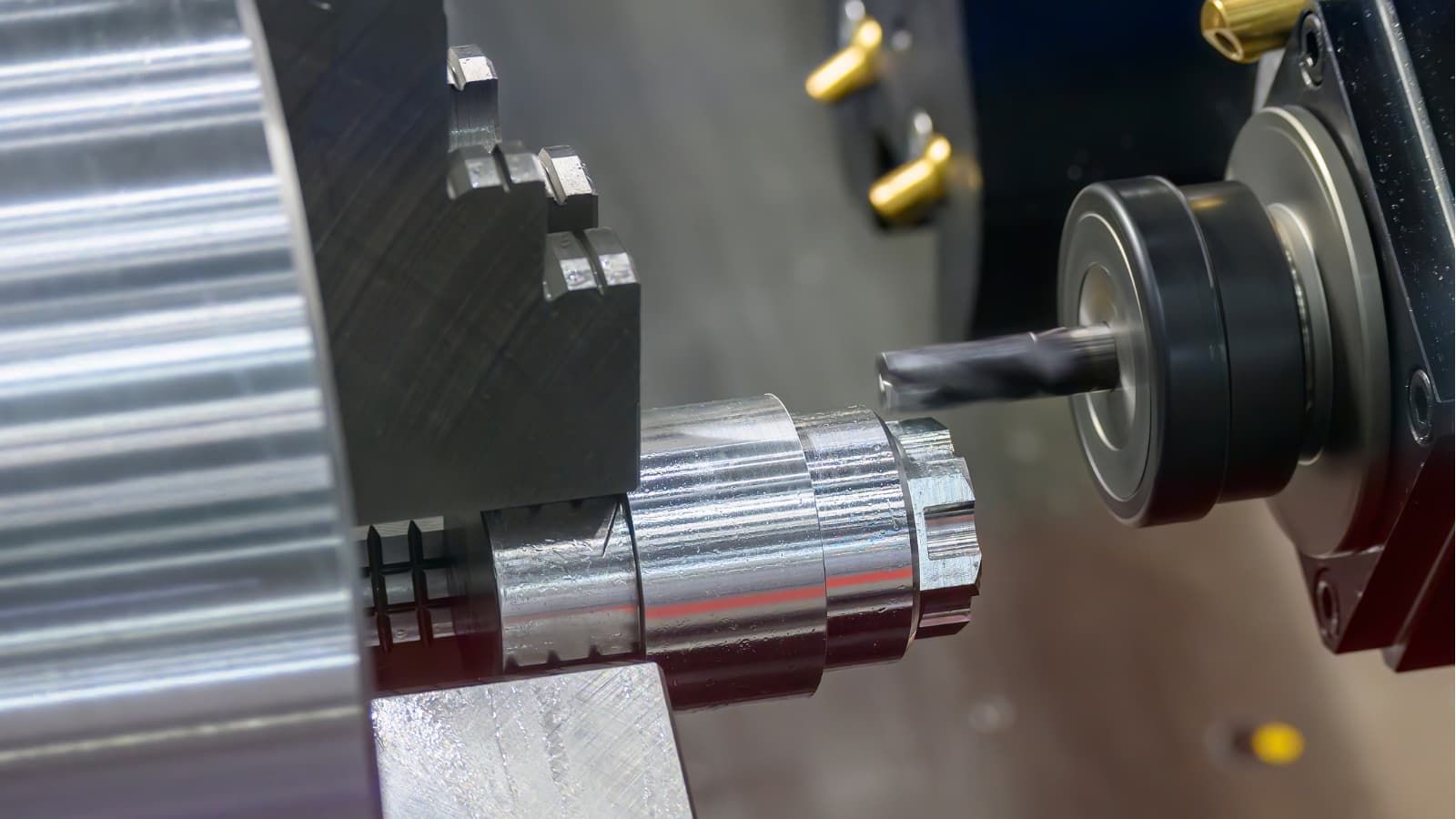
Also known as the “Mother of all Machines,” a lathe machine is an old and versatile machine that dates to the 13th century in Egypt. It functions in shaping materials like metals and wood and operates using the holding and rotating mechanism.
There are stationary cutting tools mounted on the lathe and they remove parts of the rotating workpiece leaving behind a shaped workpiece according to the product design.
Types of CNC Lathe Machines
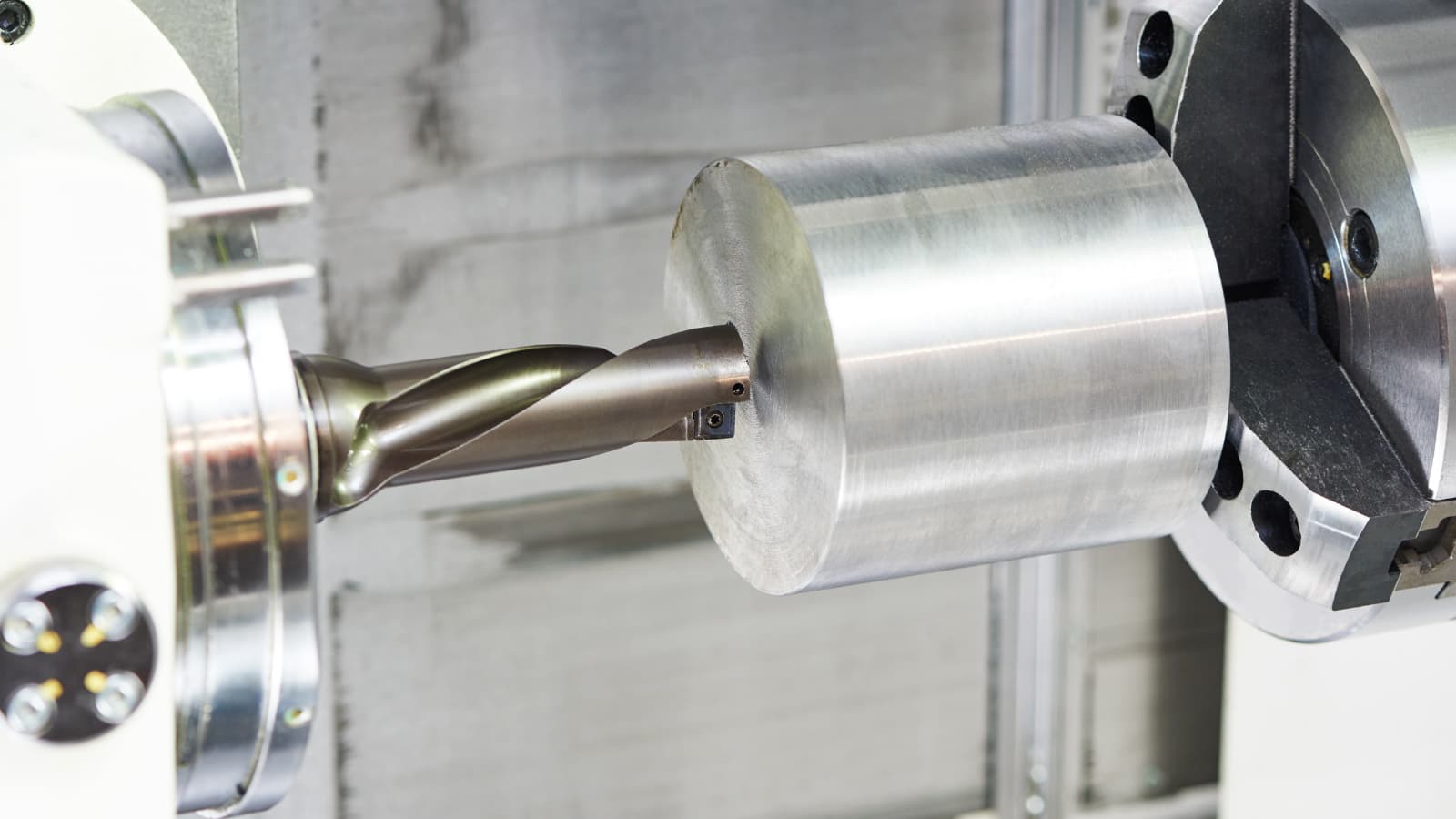
Lathe machines come in various types, such as CNC, Speed, Turret, and Engine lathes. CNC lathes are automated, offering precision and efficiency. Speed lathes are ideal for lighter tasks and have common applications in woodworking due to their simpler operation. Engine lathes serve as versatile, general-purpose machines suitable for a wide range of applications. On the other hand, Turret lathes are ideal for rapid tool changes, making them efficient for high-volume production. They are particularly adept at handling products with complex designs.
Main Parts of a Lathe Machine
The main parts in a lathe are the headstock, tailstock, bed, spindles, motor, and tool rest. The bed forms the lathe’s base and is the part where all lathe cutting tools are attached.
The headstock is on the left of the machine and is where the main action occurs. It holds the main spindle where the power generated by the motor is applied. The tailstock is on the right of the machine and it moves along the bed and functions in supporting the workpiece thereby providing stability.
The lathe motor is below the bed but on the left near the headstock. It can be electric (most common) or hydraulic and generates the power needed. Lastly, the toolrest is responsible for the adjustment of the height and rotation of the lathe.
Classification 1: Basic Types of Lathe Tools
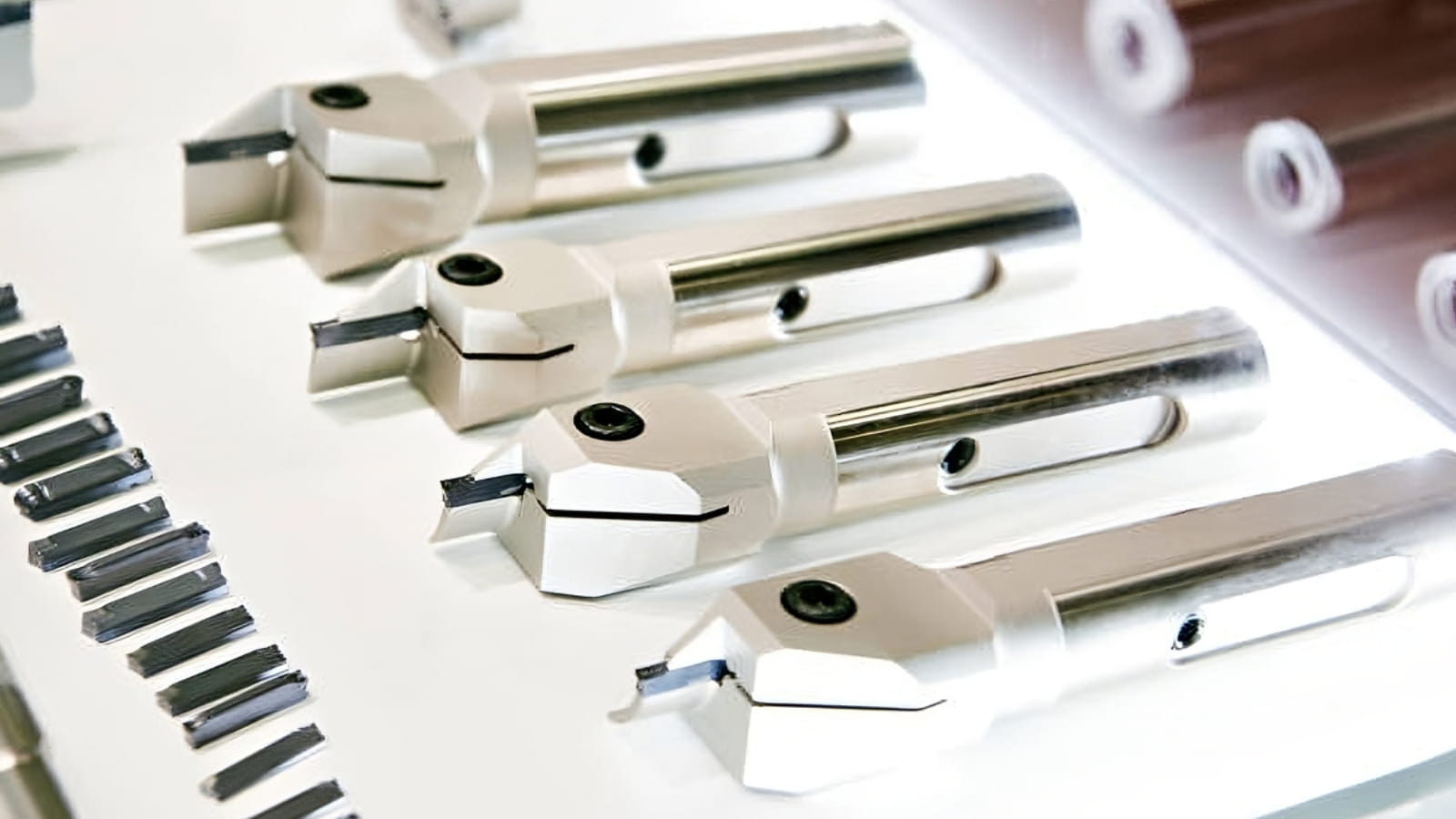
Building on the understanding of what a lathe machine is, it’s important to look at how lathe cutting tools are commonly classified. This classification revolves around the specific machining or cutting operation they are designed for.
Turning tools
Lathe turning tools remove part of a rotating workpiece along a length leading to a final part with a reduced diameter. There are two types: rough and finish turning tools employed in the CNC turning process.
- Rough turning tools remove excess materials from the workpiece due to their ground-cutting angle that can withstand maximum pressure during machining.
- Finish turning tools on the other hand can only remove small parts of the workpiece leading to a final part with a smooth and accurate finish.
Facing tools
A lathe facing tool is similar in design to a conventional face milling tool characterized by a side cutting edge. It is applicable in facing operations, i.e., the removal of layers of materials from the workpiece to produce a smooth or rough surface depending on parameters like speed. There are two types: right- or left-hand facing tools.
- A right-hand facing tool functions on the workpiece’s right-hand side.
- While the left-hand facing tool functions on the workpiece’s left hand side.
Regardless, the face tools are applicable in creating a flat surface on a part.
Boring tools
Carbide boring tools have a characteristic boring bar and a cutting tool at their end. There are two types: Single point boring bars characterized by a single cutting edge and multi-point boring bars that have multiple cutting edges.
Boring tools mounted on a lathe machine are applicable in enlarging existing holes or creating internal shapes within a workpiece.
Chamfering tools
A chamfering tool functions in creating a chamfer, i.e., a slanting edge on the corner of a workpiece. They are made from materials such as high-speed steel or carbide and have three different subtypes namely the single angle, variable angle, and indexable chamfer tool.
- A single-angle chamfer tool can create a chamfer having a constant angle along the entire length of the cut.
- A variable angle chamfer tool allows the adjustment of the chamfer angle allowing machinists to create chamfers with multiple angles.
- The indexable chamfering tools have replaceable inserts which make it possible to change the angle and increase the flexibility of the chamfering process.
It is also possible to use turning lathe tools for chamfering by setting it at a right angle to the workpiece. However, take note to not set the inclination angle so high as this can render them obsolete.
Thread Cutting tools
These types of lathe cutters are applicable in making spiral thread patterns on a cylindrical workpiece. They have a nose angle that determines the thread angle and a cross-section that determines the thread pitch. There are two types of thread cutting tools namely internal and external thread cutting tools.
- An internal thread-cutting tool or tapping tool creates a thread in a hole.
- While the external thread-cutting tool for creating threads on the workpiece surface.
Thread-cutting tools are suitable for creating threads in parts such as bolts, and nuts and for tapping (creating internal threads).
Knurling tools
Knurling tools are another type of cutting tool that has two or more metal rolling wheels having embossed patterns. There are different types depending on the embossed parts with two common types being the straight knurling tools for creating straight patterns and the diagonal knurling tools for creating diagonal or diamond-shaped patterns.
Knurling tools are applicable in creating a raised pattern on a workpiece surface for better grip or aesthetics.
Classification 2: Specialized Lathe Cutting Tools
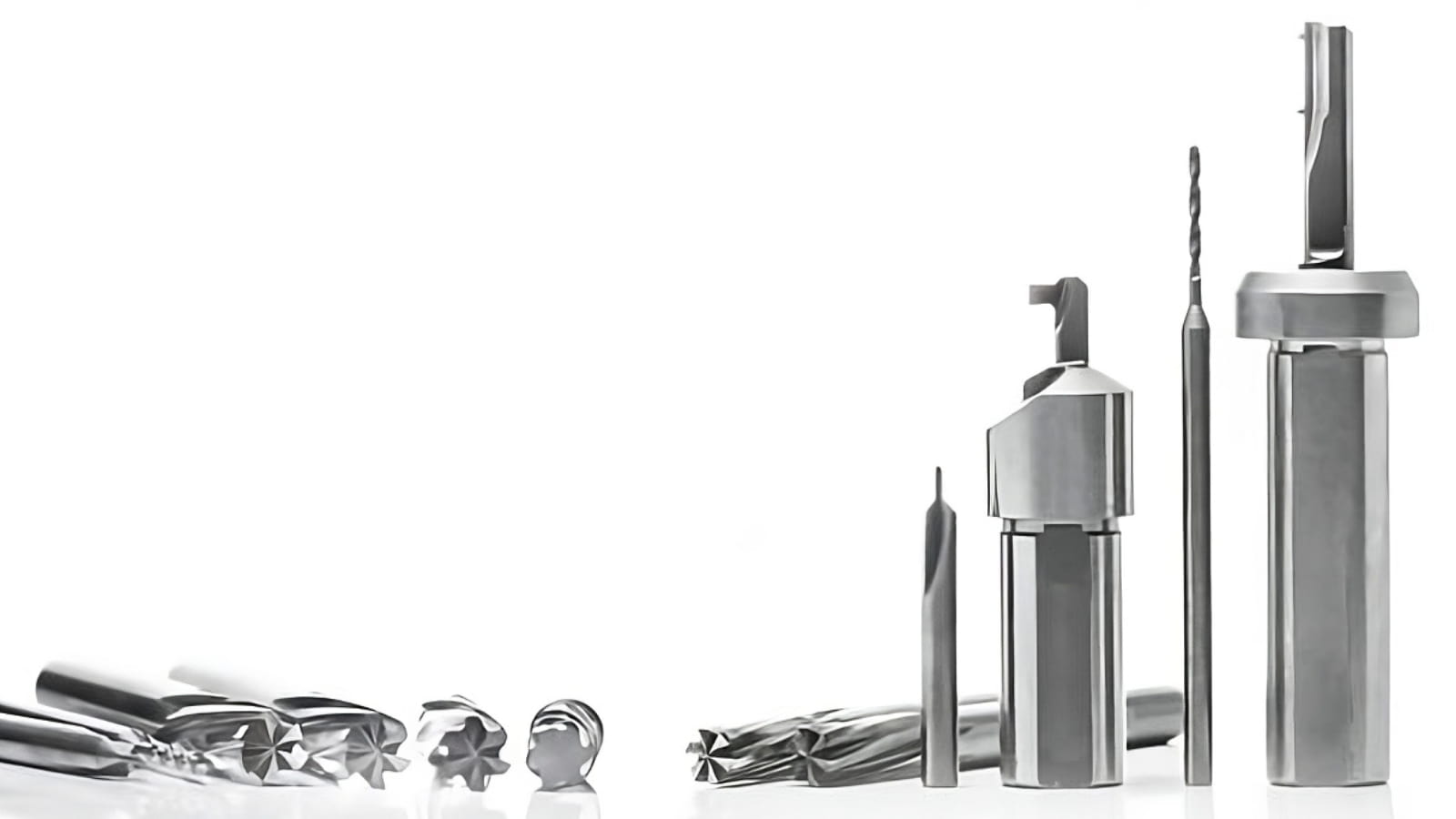
Specialized types of cutting tools for CNC lathes stand out from standard cutters in terms of designs and applications and are suitable for specific machining requirements. They include:
Forming tools
Forming tools are made by combining turning and grooving tools and are suitable for making parts with complex shapes. They have custom profiles tailored to specific shapes and are more accurate and production-efficient.
Forming tools are suitable and critical in CNC precision machining and are popular in contour machining for concave or convex shapes and making parts that require high precision and accuracy such as gears.
Taper Turning Tools
Taper turning tools are designed for machining tapered surfaces, adept at either reducing or enlarging the diameter of a workpiece. They excel in producing tapered shafts where the diameter changes along the length of the workpiece and are crucial for creating conical features essential in various machining operations. These tools are indispensable in the automotive, aerospace, and manufacturing industries, particularly for crafting components such as shafts, cones, and nozzles.
A key feature of taper-turning tools is their adjustable angled cutting edge. Operators can set this edge to various angles relative to the lathe’s axis to meet the specific requirements of the workpiece. This adjustability allows machinists to precisely shape different materials and sizes, making these tools a valuable asset in precision engineering and custom part production.
Grooving tools
Grooving tools are applicable in making grooves on workpieces with cylindrical surfaces. They come in several shapes depending on the lathe machine, with the common ones being V-shaped and square-cutting tools.
Grooving tools have a narrow cutting edge which makes them suitable for making slots, grooves, or parting on a workpiece at a specific cut depth. Furthermore, they have efficient chip evacuation from the cutting zone.
Classification 3: CNC Lathe Tools Based on Materials
Cutting tools for metal lathes can also be classified based on their material makeup. Common materials used in making different types of lathe tools include:
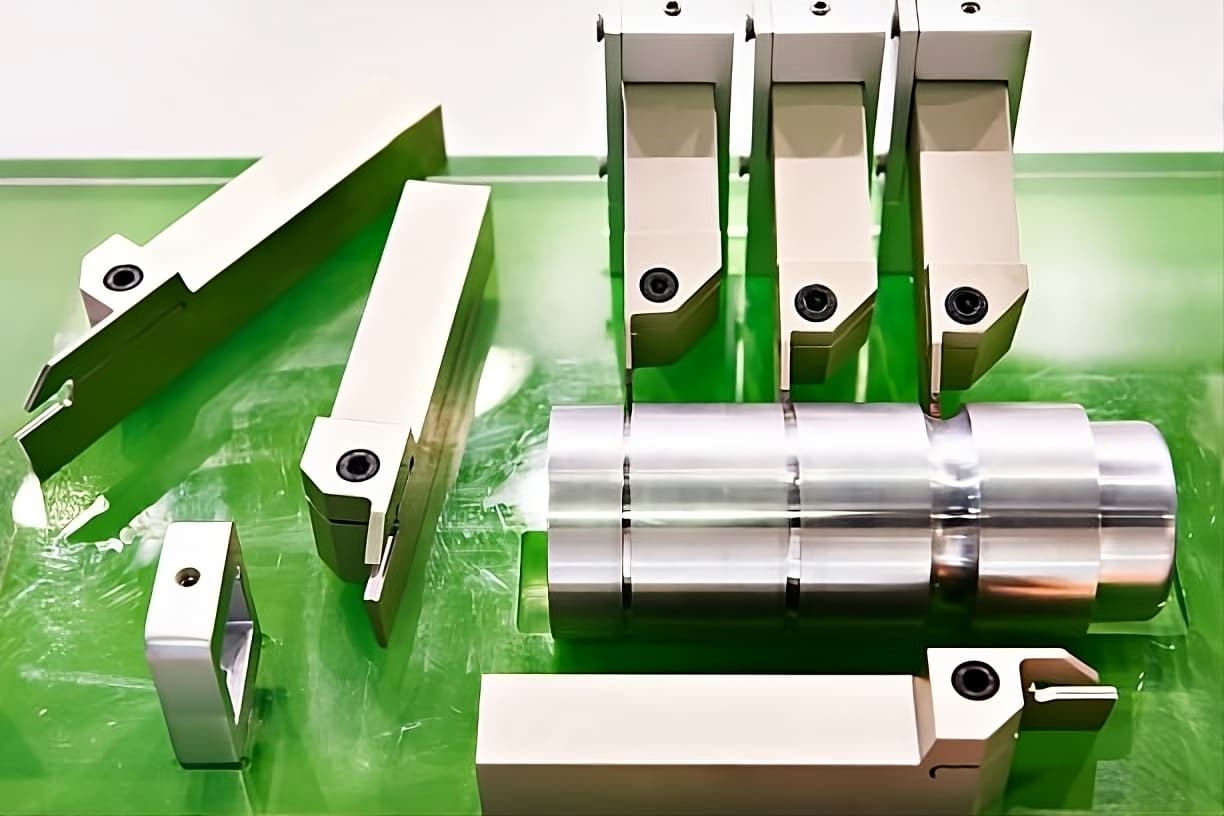
High-speed steel
Lathe cutting tools made from high-speed steel are hard, strong, and wear-resistant. The material contains elements like carbon, tungsten, chromium, and vanadium and can work well at a temperature of about 5880C.
High speed steel (HSS) tools are affordable and are popular in moderate-speed lathing operations such as rough and semi-finish machining due to their versatility. However, they are unsuitable for high-speed machining and they require frequent tool changes.
Carbide
Carbide lathe cutters stand out for their exceptional hardness and durability, outperforming traditional high-speed steel tools. Manufacturers can enhance these properties by adding elements like tungsten, carbon, vanadium, and chromium. Additionally, applying coatings of materials such as Aluminum Oxide and Titanium Nitride further increases their effectiveness. Their key benefit lies in maintaining a sharp cutting edge at high machining temperatures, making them ideal for high-speed and heavy-duty machining applications.
Carbide tools excel in cutting hard materials like stainless steel and cast iron, offering improved surface finishes and precision. Their longevity and ability to handle tougher jobs reduce the frequency of tool changes, enhancing overall productivity. While more expensive up front, their extended lifespan and efficiency make them cost-effective for industrial use.
Diamond
Diamond tools for lathe machines, known for being the hardest material, offer unparalleled performance in precision machining. Their primary benefit is exceptional wear resistance, enabling them to maintain sharpness and accuracy over extended periods, even at high cutting speeds. These tools are ideal for machining highly abrasive materials like composites, aluminum alloys, and ceramics, ensuring smooth finishes and dimensional accuracy.
They are particularly valued in industries requiring ultra-fine finishes, such as aerospace and electronics. Their durability leads to fewer tool changes and reduced downtime, making them a cost-effective choice despite their higher initial cost.
Ceramic
Ceramic CNC lathe cutters stand out for their exceptional heat resistance and durability, ideal for high-speed machining of hard-to-machine materials like hardened steels, nickel-based alloys, and titanium. Their resistance to wear and deformation under high temperatures ensures prolonged tool life and consistent performance. These tools are especially beneficial in abrasive machining environments, significantly reducing the frequency of tool replacements.
They also exhibit excellent chemical stability, preventing adverse reactions with various materials. Though initially more costly, their longevity and efficiency in demanding applications make them a cost-effective solution in industries such as aerospace and automotive manufacturing.
Cubic Boron Nitride
Cubic Boron Nitride (CBN) lathe tools are renowned for their hardness and wear resistance, second only to diamond, making them ideal for machining hard materials. Their high thermal stability ensures efficiency in high-heat machining processes, while their chemical inertness allows safe interaction with a variety of metals. These tools are particularly effective in machining hardened steels, high-speed applications, and finish machining, offering high-quality surface finishes and precision.
Despite a higher initial cost, their extended tool life and reduced need for replacements make CBN tools economically efficient in the long run, especially in high-production settings. Their durability not only enhances performance but also reduces tool change times, further streamlining manufacturing processes.
Classification 4: CNC Lathe Tools Based on Applying Speed
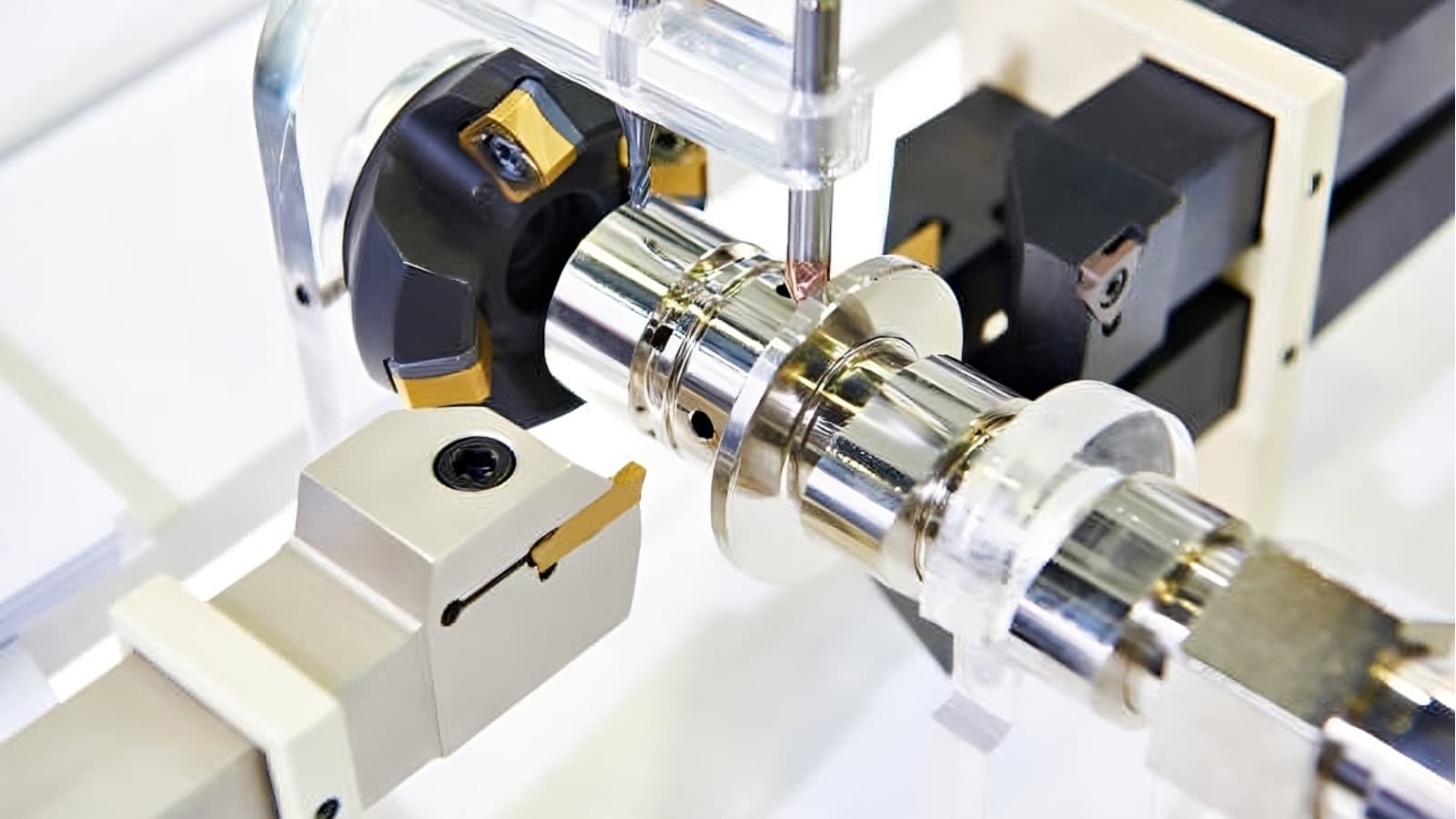
Lathe turning tools can be categorized according to the direction of feed during the machining process.
Right-Hand tools
A right-hand tool removes materials from the workpiece as it moves from right to left. Most lathe tool bits for CNC machining are readily in the right-hand design making them cheaper options. Furthermore, they cut towards the chuck and the chip formation is away from the tool which increases effective chip evacuation. They are commonly turning tools and facing tools and are applicable in creating turned parts, threading, and flat surfaces on the workpiece end.
Left-Hand tools
A left-hand lathe cutter removes materials from the workpiece as it moves from left to right. They are not common hence they are more expensive. Furthermore, they cut away from the chuck which means that the chip formation is towards the chuck. Nevertheless, they are preferable for making back turning, sharp shoulders on the workpiece back, and are the best option for short workpieces that cannot be gripped by the sub-spindle chuck.
Round Nose Tools
Rough nose tools have narrow tips with no side or back rake angles. Hence, they are preferable for cutting in the right or left direction. They are applicable in creating parts with smooth finish complex profiling and contouring curved surfaces or rounding corners.
Classification 5: CNC Lathe Tools Based on Structure
Lathe tools are also classified based on their structure into three major types. These are:
Single Body Tools
A single-body structure is made using a single material such as carbide, high-speed steel, or ceramic. They have a specific shape, size, and geometry and are very strong. Hence, they are the most applicable types of lathe tools in standard machining operations.
Welding Lathe Cutting Tools
Welding is a key process in the fabrication of cutting tools for CNC lathes, involving the joining of different materials. This technique allows for the creation of custom geometries, modification of existing tools for new applications, and the replacement of cutting inserts. The result is a cost-effective and versatile solution, especially useful in scenarios requiring the adaptation of tools for new or complex parts. Welded cutting tools are particularly prevalent in settings where frequent modifications are needed.
Clamp Lathe Cutting Tools
Clamp lathe tools using temporary joining methods. They are a dexterous tooling option as they encourage easier insert replacement and the use of inserts with multiple cutting edges. As a result, they are applicable in operations where there is a constant need for replaceable tool bits used in a lathe machine.
What to Consider When Choosing a Lathe Tool
Consider the following factors when selecting a lathe tool for the success of machining operations.
Workpiece Material and Properties
The material composition of the cutting tool must be stronger, more durable, and harder than that of the workpiece for efficient machining. If this aspect is overlooked, it can result in the tool chipping or breaking. For instance, machining hard materials like titanium necessitates tools made of tougher substances, such as diamond, which are more effective than high-speed steel (HSS) options.
Desired Surface Finish and Tolerances
The desired surface finish and tolerance will determine properties such as sharpness and rake angle of the lathe tool. For example, to achieve a smooth surface finish, metal lathe tools with high rake angles and sharp cutting edges are preferable. On the other hand, a tight tolerance is achievable by using small dimensionally stable materials like carbide.
Cutting Speed, Feed Rate, and Depth of Cut
It is important to consider the operation cutting speeds, feed rates, and cut depths as they will determine the strength and classification of the lathe tool. For example, single-body tools, coated or made from carbide and diamond, excel in high cutting speeds and feed rates due to their superior strength, hardness, and durability. A higher depth of cut also means that the tool must be long enough to have a good chip evacuation mechanism.
Machine Tool Capabilities and Limitations
The lathe machine capability can influence the production cycle times and the right use of turning tools. For example, rigid equipment used in large-scale operations will require the use of lathe cutters made from strong materials like carbide that can handle higher cutting forces and operation conditions. Furthermore, some machines with multiple tool-holding devices in a lathe will promote the use of multiple lathe tools leading to a decrease in production cycle time.
Technological Advances in Lathe Cutting Tools
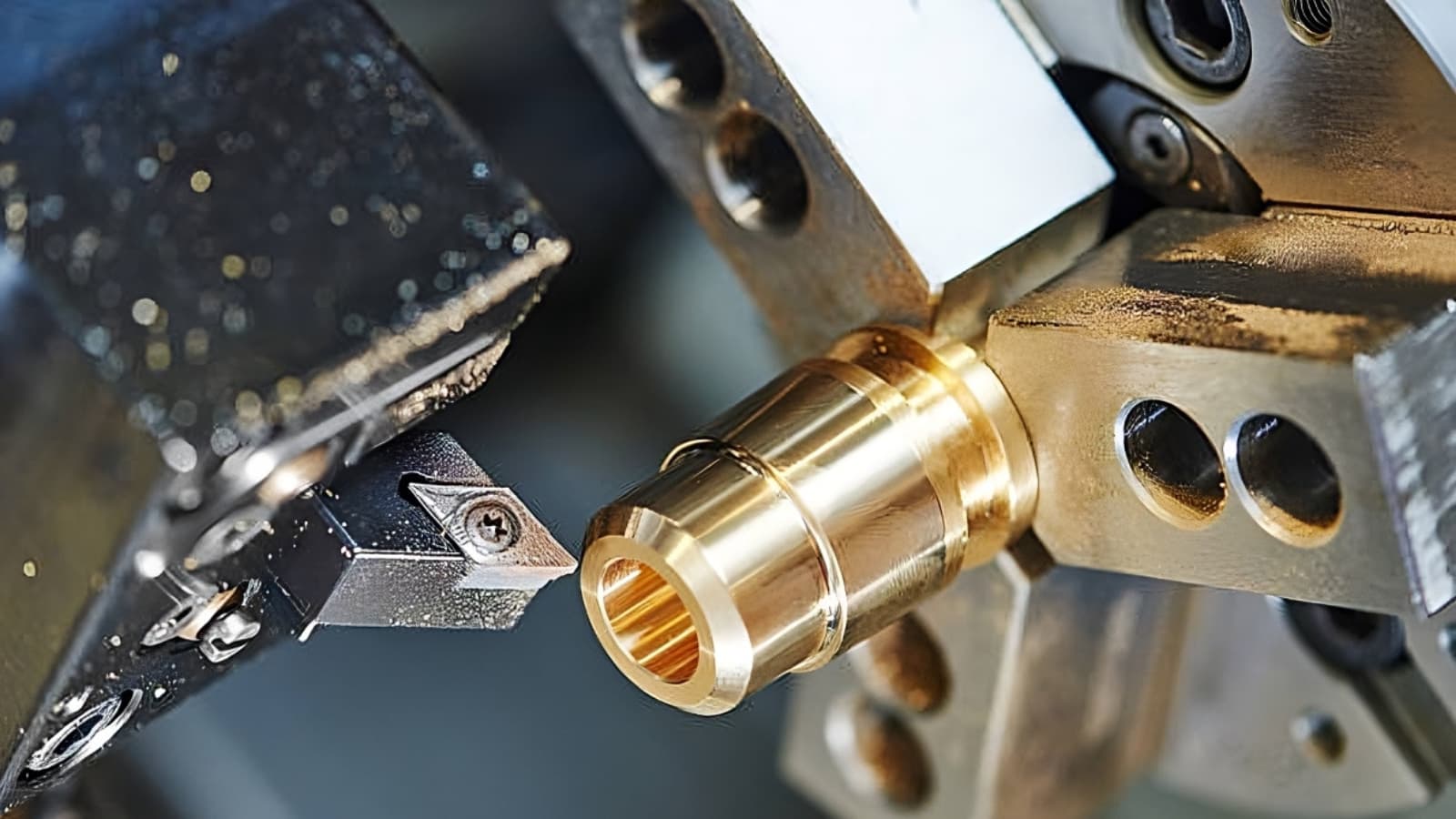
Several technological advances in tool manufacturing have contributed to better tool bit production and enhancement of the tool’s precision, efficiency, and versatility. A few advancements include:
Advanced Materials
There is now an increase in the use of advanced materials with enhanced properties such as hardness, thermal stability, toughness, and wear resistance for improved performance.
Common advanced materials are high-performance carbide grades and ceramics like silicon nitride and alumina. Also, coatings such as TiAlN (Titanium Aluminum Nitride) and AlTiN (Aluminum Titanium Nitride) are now common in lathe tool manufacturing due to their improved mechanical properties.
Improved Tools Geometry
Modern turning tools, now featuring unique geometry, are used in lathe machines to enhance machining efficiency. These tools incorporate advancements like chip breakers, which improve chip evacuation and surface finish. Additionally, their design now includes variable helix and pitch, which significantly reduces vibration and enhances stability during the lathing process.
Computer-Aided Design (CAD) and Simulation
With CAD software and simulation tools, lathe-cutting tool manufacturers can virtually prototype the tools and optimize their geometries. This can allow them to predict the tool’s performance before their production.
Furthermore, with Finite Element Analysis (FEA), manufacturers can simulate the turning tools’ behavior under various machining conditions. As a result, this enables the development of stronger and more efficient cutters.
Sensor Integration
Some tool bits for lathe machines are now integrated with sensors which allows manufacturers to monitor parameters such as temperature and vibration in real time. As a result, it is possible to optimize the tools, reduce tool wear, and enhance their use.
Additive Manufacturing
Additive manufacturing techniques have become instrumental in producing complex and customized cutting tools for lathes. This innovation simplifies the creation of specialized tools with intricate designs, tailored for specific machining needs.
Meeting Modern Machining Needs with RapidDirect Solutions
Are you looking for a reliable and reputable partner for your lathe tools machining needs or custom machined parts? Choose RapidDirect for a top-quality experience. Upload your CAD file on our online quotation platform and get instant quotations with an automated DfM report. Furthermore, you can also manage and track your order until delivery!
At RapidDirect, we focus on delivering quality manufacturing solutions to our clients by leveraging innovative technology and experienced teams. Our team of engineers have extensive knowledge about machining tools and our recurring use of these tools puts us at the forefront of custom machining.
Conclusion
This article delves into the various forms, structures, and materials of lathe tools, highlighting how these differences impact their applications and the quality of the final product. It aims to enhance your understanding of different types of tools by classifying them based on function, structure, design, and other criteria.
After reading this article, you’ll be better equipped to select the appropriate tool for your needs. Additionally, if you require custom solutions for lathe tool machining or need bespoke machined parts, please feel free to contact us. We’re here to assist you in starting your projects.
FAQs
Lathe tools are mounted on a lathe machine where they help in cutting part of a rotating workpiece to form a required shape. This is achievable using lathing operations such as turning, grooving, and chamfering.
A right-hand tool has its cutting edges on its right side. It is suitable for cutting on the workpiece’s right side and it removes parts of a workpiece as it moves from right to left. On the other hand, a left-hand tool has its cutting edges on the left side and it works on the workpiece left side while removing parts of the workpiece as it moves from left to right.
Yes, the same cutters can work for different materials as some lathe tools are versatile. For example, carbide tools are suitable for ferrous and non-ferrous workpieces. However, some cannot for example, HSS lathe tools are only suitable for soft materials like aluminum. The choice of lathe tool depends on factors like tool material makeup and coating.
The feed direction is significant in the lathe tools as it can affect the tool’s life. Using the tool in the right direction can result in an even distribution of the wear across the cutting tool’s cutting edge. Choosing the right feed direction also affects the final part’s surface finish, chip formation, and power consumption.


